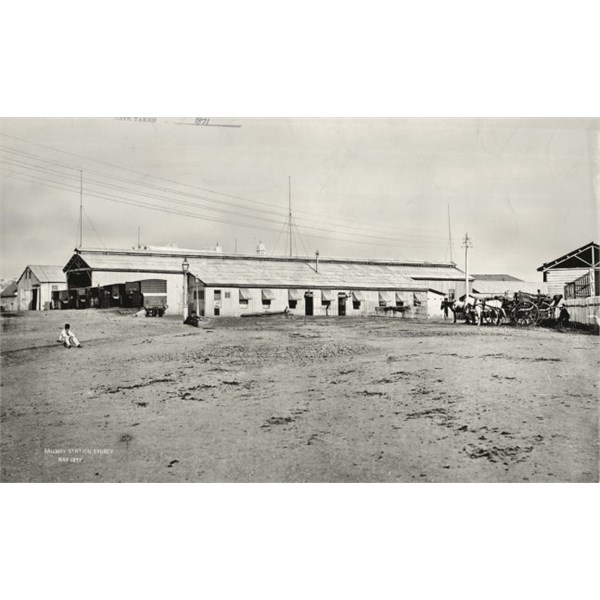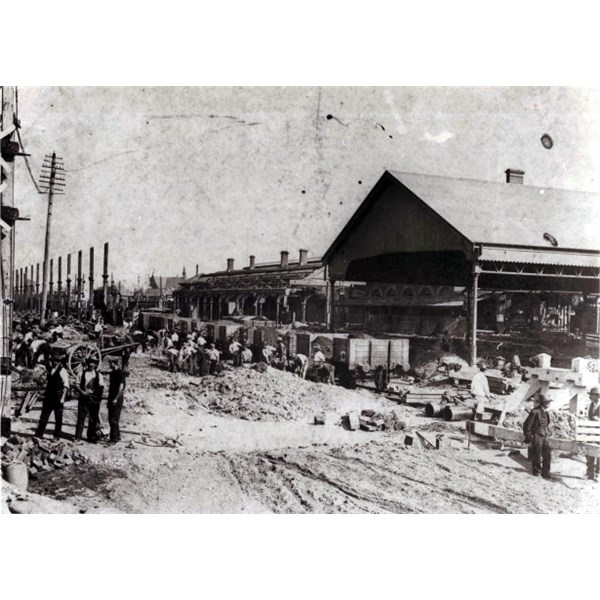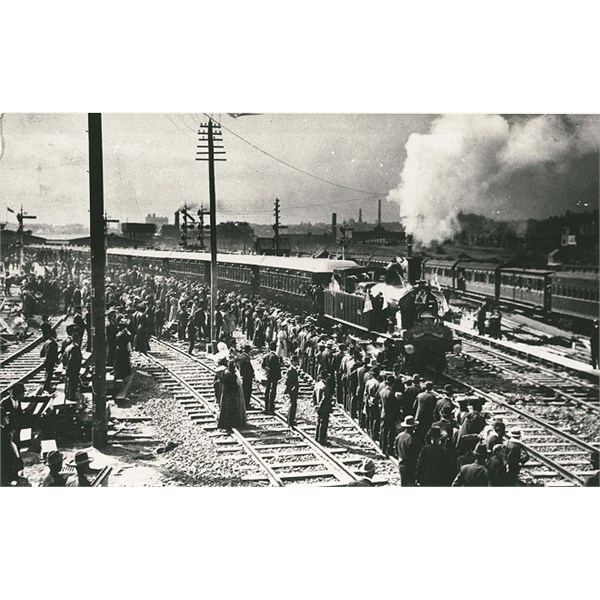The first railway line in
Sydney opened in 1855 and operated between
Sydney and Parramatta. The
Sydney terminal station was built in September 1855 on the site of the ‘Cleveland Paddock’, situated between Devonshire and Cleveland streets. The station was commonly referred to as Redfern Station as it was located close to Redfern. The station has been described as a “temporary tin shed” ), due to the fact it was a single 30m long wooden platform in a corrugated iron shed . In 1856 additional railway sheds and yards were added to the site but by the early 1870s the station was unable to meet the demands of the rapidly growing railway network in
Sydney.

First Sydney Railway Station, 1871.
The second terminal station was designed by the Railways Chief Engineer John Whitton (who designed the Zig Zag railway in the Blue Mountains). It opened in 1874 on the same site as the first station and continued to be known as Redfern. Whitton described the station as a through station to allow for the future expansion of the railways. While the brick and stone building was impressive when first built, by the 1880s platforms (upto 13 in total) had spread to the forecourt area.
The new station's design incorporated stone and brick and was considered one of the most impressive public buildings in
Sydney at the time. It was designed for through trains to allow for future expansion of the railway network into the City. This was never realised however, and the restricted site was soon under pressure to cope with traffic levels
well beyond its capacity.

Goods yard, depot and machine shop at second Sydney Railway Station, c.1874

Second Sydney Railway Station, 1879

Second Sydney Railway Station on corner of Devonshire and George Streets, c.1900
The goods yard and sheds to the east of the station added to the chaotic activity at the congested site which by the late 1890s was becoming acute, with 25 million passengers passing through the station in 1899. In addition, the increased length of the trains using the station was severely hampering its effectiveness, while its distance from the city centre required commuters to change to crowded trams for the remainder of their journey through the congested streets of the central business district.
Sydney's
Central Station - the third and current '
Sydney' station
The plan to shift the
Sydney terminal station to the north side of Devonshire Street was proposed by the Minister for Public Works, E.W. O’Sullivan. Government Architect W.L. Vernon designed a 15 platform steel-framed and concrete station . Parliament approved the Act for its construction on 11 December 1900 at an estimated cost of £561, 000 . The design for the station included a large arched roof to cover the main concourse area, with covered platforms and pedestrian access through subways between George St West and Strawberry Hills. Railway Square became a major tram interchange point. The
sandstone used in the construction came from the Pyrmont Quarry, they supplied the
sandstone for piers, ramps and walls; to face more than 2.5 kilometres of platforms, 3,800,000 bricks would be needed. Hand carved cedar surmounted the main doorways while stained glass windows ornately displayed the New South Wales Government Railway's insignia. The decorative marble came from Brenore, near
Orange and the ticket office was made of Tasmanian
blackwood. The clocktower (construction began on this in 1915) stands 85.6m above mean sea level and includes four clock faces that are 4.77m in diameter .

Construction work of 3rd Station at the Devonshire St end, c.1902.

First train leaving Central Railway Station, 1906

Laying the foundation stone for Central Railway Station, Sept 1906
Laying the foundation stone of
Central Station's clock tower, 26 September 1903.W.L. Vernon, the New South Wales Government Architect in charge of design, and Henry Deane, Engineer in Chief of the New South Wales Government Railways, signed the completed plan for the new 15-platform steel framed and concrete station on 2 November 1901.
Before construction could begin the site had to be cleared of the rail sheds and yards. Property resumption included the Benevolent Asylum, Devonshire Street
Cemetery, Christ Church Parsonage, Police Barracks,
Sydney Female Refuge, Convent of the Good Samaritan and the South
Sydney Morgue . At the Devonshire Street
Cemetery site, £27, 890 was spent on relocating the remains and headstones to a new
cemetery site at Botany and around
Sydney 
Completed clock tower, 1920
One of the first trams to use the new colonnade platform.When the new station was constructed, the Pitt and Castlereagh streets tramway loop was relocated so the trams could terminate in a colonnade across the front of the main concourse at platform level, providing a convenient means of transfer between the two transport modes. The trams approached the terminus by way of a ramp from the corner of Pitt and
Hay streets.
The tramline to the colonnade ceased on 29 September 1957, however, in 1997 trams made a welcome comeback with the opening of the light rail line servicing
Wentworth Park and later Lilyfield. Railway Square was also a large tram interchange point being only a short walk from
Central Station or through the Devonshire Street Tunnel. Today, Railway Square interchange is for buses.
.